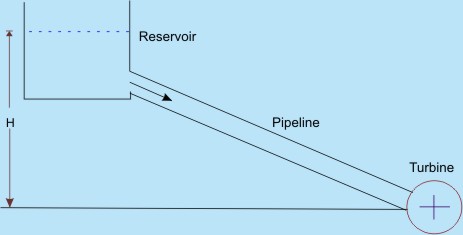Power Transmission By A Pipeline
-
In certain occasions, hydraulic power is transmitted by conveying fluid through a pipeline. For example, water from a reservoir at a high altitude is often conveyed by a pipeline to an impulse hydraulic turbine in an hydroelectric power station. The hydrostatic head of water is thus transmitted by a pipeline. Let us analyse the efficiency of power transmission under this situation.

Fig. 37.3 Transmission of hydraulic power by a pipeline to a turbine
The potential head of water in the reservoir = H ( the difference in the water level in the reservoir and the turbine center)
The head available at the pipe exit (or at the turbine entry) 
Where  is the loss of head in the pipeline due to friction.
is the loss of head in the pipeline due to friction.
- Assuming that the friction coefficient and other loss coefficients are constant, we can write
Where Q is the volume flow rate and R is the hydraulic resistance of the pipeline. Therefore, the power available P at the exit of the pipeline becomes
For P to be maximum, for a given head H, dP/dQ should be zero. This gives

|
(37.6) |
or,  |
|
 is always negative which shows that P has only a maximum value (not a minimum) with Q.
is always negative which shows that P has only a maximum value (not a minimum) with Q.
- From Eq. (37.6), we can say that maximum power is obtained when one third of the head available at the source (reservoir) is lost due to friction in the flow.
- The efficiency of power transmission
 is defined as
is defined as
 |
(37.7) |
- The efficiency
 equals to unity for the trivial case of Q = 0.
equals to unity for the trivial case of Q = 0.
- For flow to commence and hence
 is a monotonically decreasing function of Q from a maximum value of unity to zero.
is a monotonically decreasing function of Q from a maximum value of unity to zero.
-
The zero value of

corresponds to the situation given by

when the head
H available at the reservoir is totally lost to overcome friction in the flow through the pipe.
- The efficiency of transmission at the condition of maximum power delivered is obtained by substituting RQ2 from Eq. (37.6) in Eq. (37.7) as
Therefore the maximum power transmission efficiency through a pipeline is 67%.